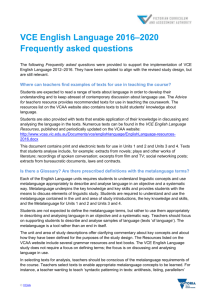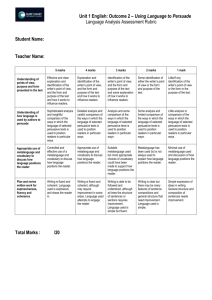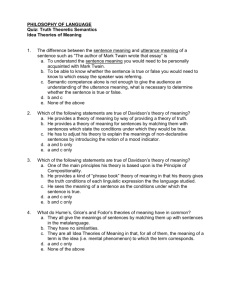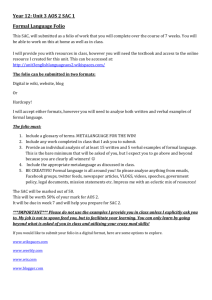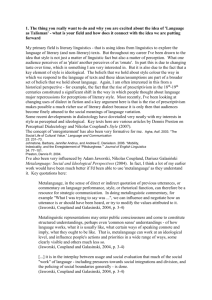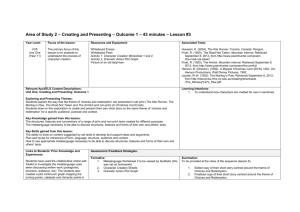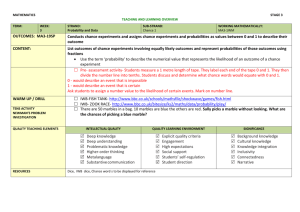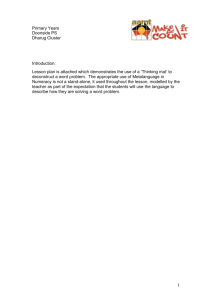Proposed changes to the VCE English Language Study Design
advertisement
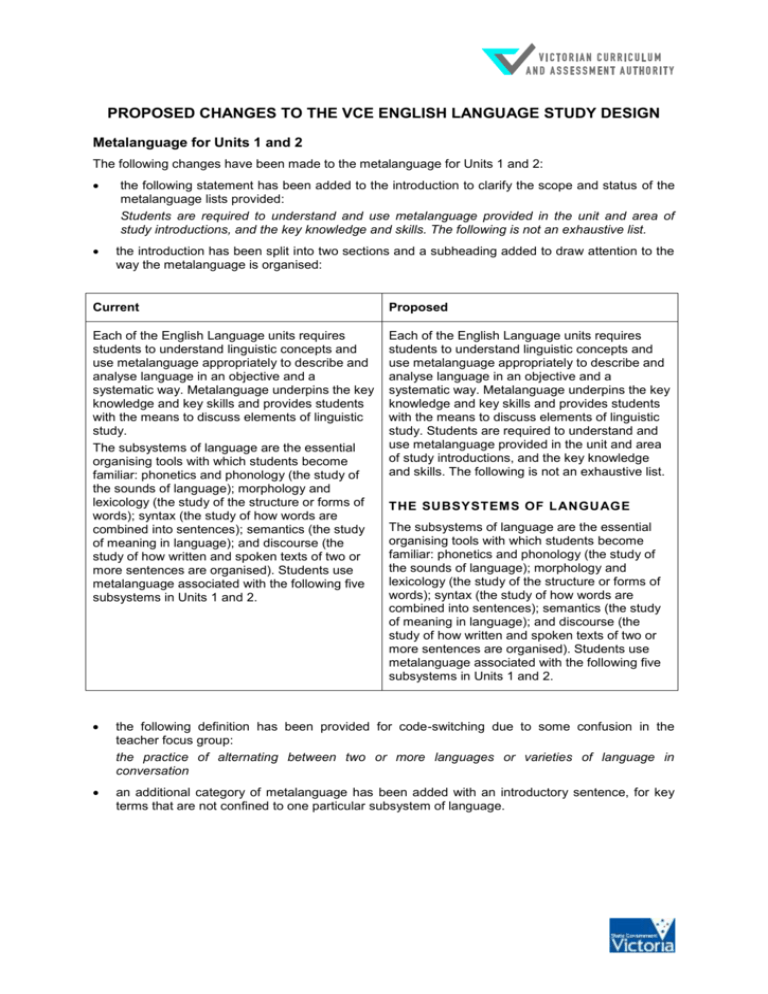
PROPOSED CHANGES TO THE VCE ENGLISH LANGUAGE STUDY DESIGN Metalanguage for Units 1 and 2 The following changes have been made to the metalanguage for Units 1 and 2: the following statement has been added to the introduction to clarify the scope and status of the metalanguage lists provided: Students are required to understand and use metalanguage provided in the unit and area of study introductions, and the key knowledge and skills. The following is not an exhaustive list. the introduction has been split into two sections and a subheading added to draw attention to the way the metalanguage is organised: Current Proposed Each of the English Language units requires students to understand linguistic concepts and use metalanguage appropriately to describe and analyse language in an objective and a systematic way. Metalanguage underpins the key knowledge and key skills and provides students with the means to discuss elements of linguistic study. The subsystems of language are the essential organising tools with which students become familiar: phonetics and phonology (the study of the sounds of language); morphology and lexicology (the study of the structure or forms of words); syntax (the study of how words are combined into sentences); semantics (the study of meaning in language); and discourse (the study of how written and spoken texts of two or more sentences are organised). Students use metalanguage associated with the following five subsystems in Units 1 and 2. Each of the English Language units requires students to understand linguistic concepts and use metalanguage appropriately to describe and analyse language in an objective and a systematic way. Metalanguage underpins the key knowledge and key skills and provides students with the means to discuss elements of linguistic study. Students are required to understand and use metalanguage provided in the unit and area of study introductions, and the key knowledge and skills. The following is not an exhaustive list. THE SUBSYSTEMS OF LANGUAGE The subsystems of language are the essential organising tools with which students become familiar: phonetics and phonology (the study of the sounds of language); morphology and lexicology (the study of the structure or forms of words); syntax (the study of how words are combined into sentences); semantics (the study of meaning in language); and discourse (the study of how written and spoken texts of two or more sentences are organised). Students use metalanguage associated with the following five subsystems in Units 1 and 2. the following definition has been provided for code-switching due to some confusion in the teacher focus group: the practice of alternating between two or more languages or varieties of language in conversation an additional category of metalanguage has been added with an introductory sentence, for key terms that are not confined to one particular subsystem of language. OTHER METALANGUAGE The following metalanguage terms are not confined to one particular subsystem of language. function, field, mode, setting, context, relationships between participants critical period of language development theories of Child Language Acquisition including behaviourism, innatism, interactionism first- and additional- language acquisition; bilingualism Indo-European language family standardisation and codification prescriptivism and descriptivism Lingua franca linguistic relativism and determinism pidgins and creoles language maintenance, shift and reclamation. Unit 1: Language and communication The following changes have been made to Unit 1: ‘gesture’ has been replaced with ‘sign’, and the following sentence has also been added, to ensure consistency across the study design and ensure there is clarity between ‘sign’ and paralinguistic features such as gestures and facial expressions. Students also consider the role of paralinguistic features in conveying meaning. Unit 2: Language change The following changes have been made to Unit 2: some minor additions to the Area of Study 2 introduction to ensure clarity and a focus on contemporary language use. Current Proposed Students explore factors that contributed to the spread of English in the past, such as trade and colonisation, and factors that contribute to the spread of English. Students consider the consequences of the growth of English as an additional or foreign language, including the development of English-based pidgins, creoles and other varieties, and its effect on indigenous languages around the world. Students become familiar with the distinctive features of a number of national, ethnic and regional varieties of English, and explore the ways that these varieties show the effects of intensive contact with other languages. They examine the ways that multilingual speakers use code-switching to mark identity and as a powerful means of inclusion or exclusion. Students develop an understanding of how change to a language has significant repercussions for its users’ cultural identity and worldview, as evidenced by the indigenous and migrant language reclamation and maintenance movements in contemporary Australian society. Students explore factors that contributed to the spread of English in the past, such as trade and colonisation, and factors that continue to contribute to the spread of English today. Students consider the consequences of the growth of English as an additional or foreign language, including the development of Englishbased pidgins, creoles and other varieties, and its effect on indigenous languages around the world. Students become familiar with the distinctive features of a number of national, ethnic and regional varieties of English, and explore the ways that these varieties show the effects of intensive contact with other languages. They examine the ways that multilingual speakers use code-switching to mark identity and as a powerful means of inclusion or exclusion. Students develop an understanding of how change to a language has significant repercussions for its users’ cultural identity and worldview, as evidenced by the indigenous and migrant language reclamation and maintenance movements in contemporary Australian society. 2 ‘linguistic determinism and relativism’ have been added to the Area of Study 2 introduction to allow for students additional time to develop their understanding of these complex concepts which are introduced in Unit 1. Students continue to explore the concepts of linguistic relativism and determinism. the addition of ‘the processes of’ to the following key knowledge to ensure clarity: the processes of language maintenance, shift, and reclamation Units 1 and 2: Assessment The assessment options for both Units 1 and 2 have been revised for clarity and consistency across the study design. Current Proposed Assessment tasks for this unit are selected from the following: Assessment tasks for this unit are selected from the following: a folio of annotated texts an essay an investigative report an analysis of spoken and/or written text a case study short-answer questions an analysis of data. a folio an investigative report a test an essay a case study short-answer questions a written or an oral analysis of data an analysis of spoken and/or written text an oral and/or multimodal presentation. Assessment tasks may be written, oral or multimodal. Metalanguage for Units 3 and 4 The following changes have been made to the metalanguage for Units 3 and 4: as per Metalanguage for Units 1 and 2, the following statement has been added to the introduction to clarify the scope and status of the metalanguage provided: Students are required to understand and use metalanguage provided in the unit and area of study introductions, and the key knowledge and skills. The following is not an exhaustive list. as per Metalanguage for Units 1 and 2, the introduction has been split into two sections and a subheading added to draw attention to the way the metalanguage is organised: Current Proposed Each of the English Language units requires students to understand linguistic concepts and use metalanguage appropriately to describe and analyse language in an objective and a systematic way. Metalanguage underpins the key knowledge and key skills and provides students with the means to discuss elements of linguistic study. The subsystems of language are the essential organising tools with which students become familiar. Students use metalanguage associated with the following five subsystems in Units 3 and 4. Each of the English Language units requires students to understand linguistic concepts and use metalanguage appropriately to describe and analyse language in an objective and a systematic way. Metalanguage underpins the key knowledge and key skills and provides students with the means to discuss elements of linguistic study. Students are required to understand and use metalanguage provided in the unit and area of study introductions, and the key knowledge and skills. The following is not an exhaustive list. THE SUBSYSTEMS OF LANGUAGE The subsystems of language are the essential organising tools with which students become 3 familiar. Students use metalanguage associated with the following five subsystems in Units 3 and 4. examples have been added to ‘morphological patterning’ ‘lexical choice’ has been added to ‘factors that contribute to a text’s cohesion’, and ‘synonymy, antonymy, hyponymy and collocation’ provided as examples of lexical choice. ‘non-fluency features’ has been added to ‘features of spoken discourse’ and ‘pauses, filled pauses/voiced hesitations, false starts, repetition, repairs’ provided as examples of non-fluency features. ‘passing the floor’ has been added to ‘strategies for spoken discourse’ ‘back-channelling’ has been added as an alternative to ‘minimal responses’ ‘semantic domains’ has been added as an alternative to ‘semantic fields’ as per Metalanguage for Units 1 and 2, an additional category of metalanguage has been added with an introductory sentence, for key terms that are not associated with any single subsystem of language. OTHER METALANGUAGE The following metalanguage terms are not confined to one particular subsystem of language. register overt and covert norms standard and non-standard English political correctness jargon slang colloquial language/colloquialisms double-speak taboo language public language rhetoric positive and negative face needs situational context cultural context social purpose. Unit 3: Language variation and social purpose The following changes have been made to Unit 3: the area of study introductions and key knowledge and skills have been amended to include both positive and negative face needs with both informal and formal texts. This supports a more complex understanding of the degree of formality of texts as a continuum, rather than binary and discrete. The teacher focus group raised this as an issue. It reflects current practice. minor amendment to the following key skill: Current Proposed define key linguistic concepts as they relate to informal language in texts use key linguistic concepts as they relate to informal language in texts 4 Unit 4: Language variation and social purpose The following changes have been made to Unit 4: ‘a range of historical and contemporary texts’ has been replaced with ‘a range texts’ as this supports the emphasis on contemporary language use. a minor addition to the unit introduction to ensure clarity: Current Proposed Students explore how language can distinguish between ‘us’ and ‘them’, thus reinforcing social distance. Students explore how language can distinguish between ‘us’ and ‘them’, both creating solidarity and also reinforcing social distance. a minor amendment to the Area of Study 1 introduction to ensure clarity: Current Proposed They consider variation between regions, a range of migrant ethnolects, and Aboriginal Englishes, in addition to exploring how the language features associated with stereotypes may be adopted subconsciously, or deliberately employed to invoke or challenge identities. They consider variation between regions, a range of migrant ethnolects, and Aboriginal Englishes, in addition to exploring how the language features associated with stereotypes may be adopted subconsciously, or deliberately employed to establish or challenge identities. minor amendments to the key knowledge for Area of Study 1 to ensure consistency and clarity: Current Proposed ways in which a variety of Australian identities can be reflected in a range of historical and contemporary texts ways in which a variety of Australian identities are constructed and reflected in a range of texts characteristics of Australian English in contrast to Englishes from other continents, in phonological, lexical, prosodic, and/or grammatical patterns characteristics of Australian English in contrast to Englishes from other continents, in phonological, morphological, lexical, and grammatical patterns attitudes within society to different varieties of English, including prescriptivism and descriptivism attitudes within society to different varieties of Australian English, including prescriptivism and descriptivism Note that ‘prosodics’ is covered by ‘phonological’, and ‘morphological’ was an omission. minor amendments to the key knowledge for Area of Study 2 to ensure consistency and clarity: Current Proposed representations of individual and group identities in a range historical and contemporary texts representations of individual identities in a range of texts and group 5 Unit 3: Assessment The assessment options for Unit 3 have been revised for clarity and consistency across the study design. Changes are as follows: Current Proposed Analysis of one or more samples of informal language in any one or a combination of the following: Analysis of one or more samples of informal language in any one or a combination of the following: an essay a written report of an investigation a folio a short-answer test an oral presentation a multimodal presentation. a folio of annotated texts an essay an investigative report an analytical commentary short-answer questions. Assessment tasks may be written, oral or multimodal. The total length of the student responses should be approximately 600-800 words. Analysis of one or more samples of formal language in any one or a combination of the following: Analysis of one or more samples of formal language in any one or a combination of the following: an essay a written report of an investigation a folio a short-answer test an oral presentation a multimodal presentation. a folio of annotated texts an essay an investigative report an analytical commentary short-answer questions. Assessment tasks may be written, oral or multimodal. The total length of the student responses should be approximately 600-800 words. Unit 4: Assessment The assessment options for Unit 4 have been revised for clarity and consistency across the study design. Changes are as follows: Current Proposed For each outcome, any one or a combination of the following: For each outcome, any one or a combination of the following: an essay a written report of an investigation an analysis of one or more texts a folio a short-answer text an oral presentation a multimodal presentation. a folio of annotated texts an essay an investigative report an analytical commentary. Assessment tasks may be written, oral or multimodal. The total length of the student responses should be approximately 600-800 words. 6
